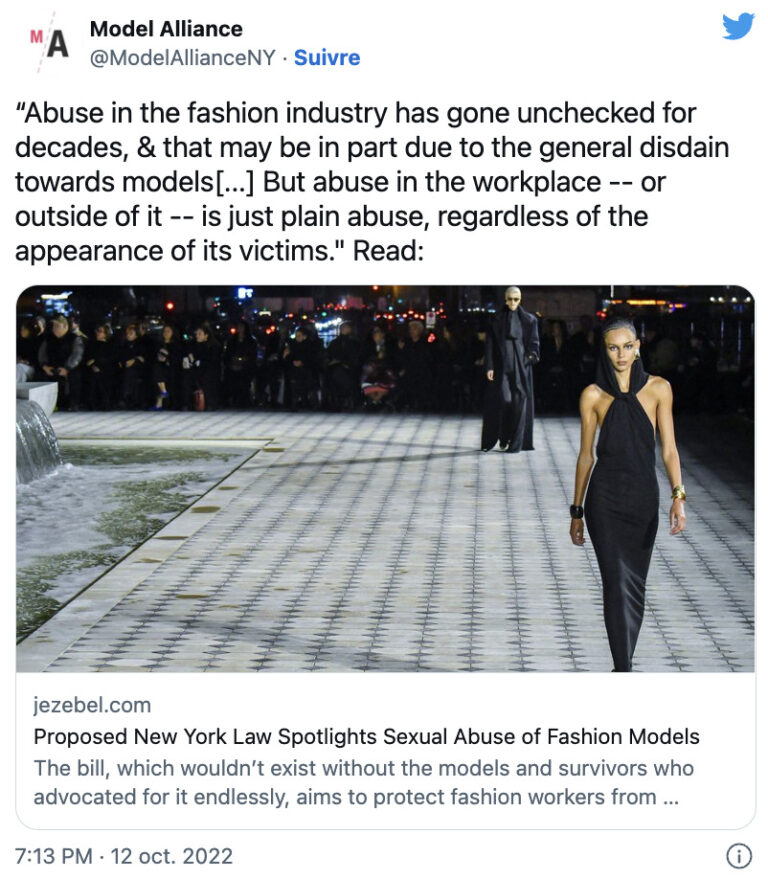The fashion capital of the United States is considering a law called the Fashion Workers Act to combat some abuses that abound in the fashion industry, including economic violence and sex trafficking, even human trafficking.
The era of supermodels so famous that it was enough to say their name to identify them (hello Naomi Campbell, Linda Evangelista or Carla Bruni) is long over. Since then, anonymous models have succeeded in a strange form of anonymity, apart from a few rare exceptions, often born well enough to break into the industry (hello Gigi and Bella Hadid or even Hailey Bieber and Kendall Jenner).
In the context of this globalized industry, which employs very young women for whom it is often their first job and who come from all over the world, it promotes economic, sexist and sexual violence, like our investigation into the impossible union at the top. However, a modeling association has been pushing the Fashion Workers Acta bill that could be a game changer in the United States.
What is the Fashion Workers Act that wants to protect models in New York?
This New York State law aims to prevent economic, gender and sexual abuse by establishing workplace safeguards, for models, but also make-up artists, hairdressers, stylists and other precarious creatives in the sector. Unveiled in the spring of 2022, it will be re-studied during a legislative session in January 2023, in the hope of being adopted.
The Fashion Workers Act wants management agencies to pay for their talent within 45 days of completing an assignment and provide them with copies of their employment contract. Commissions would be capped at a maximum of 20% and it would become forbidden to impose often exorbitant signing and accommodation fees above the housing market. These agencies should also obtain a license to have the right to practice.
Because, there, the creatives are for the most part self-employed and appeal to ” management company “ (the management agencies in question) in the hope of making life easier for them. However, there is no license or regulation for them to exercise, and they can therefore accept many contracts, payments and transfers of image exploitation rights, in place of the creatives they represent … without notice. They can also deduct expenses from them (for signing them, finding accommodation for them, or many other less legitimate pretexts). A huge legal vacuum reigns in favor of dishonest agencies that grant themselves full powers over their talents, then in the grip of the worst violence.
In New York, more than 180,000 people (or 6% of the city’s workforce) work in the industry and account for $ 10.9 billion in wagesaccording to Model Alliance. A lot of that money is slipping away from major stakeholders in this hiring structure game that reminds us of just how Wild West it is when it comes to worker rights in the US, even in fashion that wants to portray itself so glamorously.

What is it really for models in France?
But what about France? The issue has been legislated since at least 2004, the year in which the famous National collective agreement for models, extended to all potential model employers on French soil. In France, therefore, they are not self-employed, but employees of modeling agencies obliged to act in their best interest according to the strict blue-white-red labor code. Any violation is costly, not only for the fine, but also for the risk of losing the license, which is mandatory to exercise.
In addition to this protection, the charter co-signed in 2017 by Kering and LVMH for the well-being of the models. This provides in particular that minors under the age of 16 cannot be hired, that models must be at least 32 years old and have a medical certificate attesting to their good state of health. And since they are the two most powerful luxury groups in the world, their influence is international, which makes this card the closest thing to an impossible international modeling convention. Other international modeling agencies like IMG also apply strict rules in favor of their talents.
Read also:
Jean Paul Gaultier, sued for embezzlement of La Vénus de Botticelli
Front page photo credit: Pexels – 2286921 from Pixabay via Canva.


